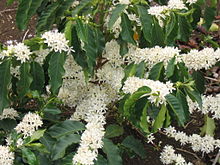| Coffea | |
|---|---|

| |
| Flowering branches of Coffea arabica | |
| Scientific classification | |
| Kingdom: | Plantae |
| Clade: | Tracheophytes |
| Clade: | Angiosperms |
| Clade: | Eudicots |
| Clade: | Asterids |
| Order: | Gentianales |
| Family: | Rubiaceae |
| Tribe: | Coffeeae |
| Genus: | Coffea L. |
| Type species | |
| Coffea arabica | |
| Synonyms[1] | |
| |

Coffea is a genus of flowering plants in the family Rubiaceae. Coffea species are shrubs or small trees native to tropical and southern Africa and tropical Asia. The seeds of some species, called coffee beans, are used to flavor various beverages and products. The fruits, like the seeds, contain a large amount of caffeine, and have a distinct sweet taste.
The plant ranks as one of the world's most valuable and widely traded commodity crops and is an important export product of several countries, including those in Central and South America, the Caribbean and Africa. The coffee trade relies heavily on two of the over 120 species, Coffea arabica (commonly known simply as "Arabica"), which accounts for 60–80% of the world's coffee production, and Coffea canephora (known as "Robusta"), which accounts for about 20–40%.[2][3] Both coffee species are vulnerable to shifts, caused by climate change, in their growing zones, which are likely to result in a decline in production in some of the most important growing regions.[4][5][6]
- ^ Cite error: The named reference
POWOwas invoked but never defined (see the help page). - ^ Cite error: The named reference
:0was invoked but never defined (see the help page). - ^ Cite error: The named reference
CoffeeProductionwas invoked but never defined (see the help page). - ^ Läderach, Peter; Ramirez–Villegas, Julian; Navarro-Racines, Carlos; Zelaya, Carlos; Martinez–Valle, Armando; Jarvis, Andy (26 October 2016). "Climate change adaptation of coffee production in space and time". Climatic Change. 141 (1): 47–62. doi:10.1007/s10584-016-1788-9. ISSN 0165-0009.
- ^ Moat, Justin; Williams, Jenny; Baena, Susana; Wilkinson, Timothy; Gole, Tadesse W.; Challa, Zeleke K.; Demissew, Sebsebe; Davis, Aaron P. (19 June 2017). "Resilience potential of the Ethiopian coffee sector under climate change". Nature Plants. 3 (7): 17081. doi:10.1038/nplants.2017.81. ISSN 2055-0278. PMID 28628132. S2CID 6873955.
- ^ Worland, Justin (21 June 2018). "Your Morning Cup of Coffee Is in Danger. Can the Industry Adapt in Time?". Time. Archived from the original on 4 August 2019. Retrieved 13 October 2019.